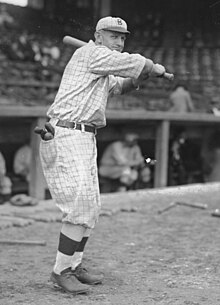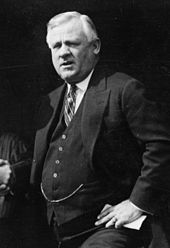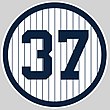Casey Stengel
After repeated clashes over pay with the Dodgers owner, Charlie Ebbets, Stengel was traded to the Pittsburgh Pirates in 1918; however, he enlisted in the Navy that summer, for the remainder of World War I.
There, he learned much about baseball from the manager, John McGraw, and had a number of highlights in his career, including hitting an inside-the-park home run in Game 1 of the 1923 World Series to defeat the Yankees.
During the 1913 season, Stengel acquired the nickname "Casey"; there are varying stories of how this came to be, though his home town of Kansas City likely played a prominent role—sportswriter Fred Lieb stated that the ballplayer had "Charles Stengel—K.C."
His wartime service was playing for and managing the Brooklyn Navy Yard's baseball team, driving in the only run to beat Army, 1–0, before 5,000 spectators at the Polo Grounds.
On June 30, 1921, the Phillies traded Stengel, Red Causey and Johnny Rawlings to the New York Giants for Lee King, Goldie Rapp and Lance Richbourg.
Stengel, at McGraw's request, acted as a coach to the young players on the "B" squad, and worked hard, getting key hits in spring training games, and making the Giants as a reserve outfielder.
Thus, the first World Series home run in old Yankee Stadium's history did not go to Babe Ruth, "that honor, with great irony, would fall to the aging reserve outfielder Casey Stengel".
On November 13, 1923, twenty-nine days after the World Series ended, Stengel was traded to the perennial second-division-dwelling Boston Braves with Dave Bancroft and Bill Cunningham for Joe Oeschger and Billy Southworth.
McGraw, with whom Stengel had remained close, wanted him to take over as manager of the Giants' top affiliate, the Toledo Mud Hens of the American Association, at an increase in salary.
Sportswriter Dan Daniel described Stengel's hiring as "the return of an ancient Flatbush landmark", which might satisfy old Dodger fans upset at Robinson's dismissal at the end of 1931.
The right fielder, Hack Wilson, lost in thought, heard the boom, assumed the ball had been hit by a batter, and ran to retrieve it and throw it to the infield, to be met by general laughter.
To that time, the club had won only one pennant, and was something of a weak sister to its crossbay rivals, the San Francisco Seals, but owner Brick Laws believed Stengel could mold the players into a winning team.
Stengel faced obstacles to being accepted—Harris had been popular with the press and public, and the businesslike Yankee corporate culture and successful tradition were thought to be ill matched with a manager who had the reputation of a clown and who had never had a major league team finish in the top half of the standings.
[92] Although platooning, playing right-handed batters against left-handed pitchers and the reverse, against whom they are on average more able to hit, had been known for some years, Stengel popularized it, and his use gave the practice its name, coined by a sportswriter and borrowed from football.
The Red Sox took the lead the following day with a comeback win in a makeup game, as Stengel lost his temper at the umpire for the first time in Yankee uniform; although he was not ejected, he was fined by the league.
Stengel, during the 1949 season, had shown himself more apt than his peers to bring in a relief pitcher, and when during the first game, starter Allie Reynolds gave up the first two runs in the third inning, the manager brought in Joe Page.
Complaints from other teams that the Yankees were violating time limits on spring training and were using their money for competitive advantage led to modifications, but the concept survived and was eventually broadly adopted.
When Sain loaded the bases with none out in the ninth, Stengel brought in Bob Kuzava, a left-hander, to pitch against the Giants, even though right-handers Monte Irvin and Bobby Thomson were due to bat.
[118] According to Richard Bak in his biography of Stengel, "people across the country grew enamored of the grandfatherly fellow whose funny looks and fractured speech were so at odds with the Yankees' bloodless corporate image".
[129] Stengel had health issues during the season, spending ten days in the hospital in late May and early June, with the illness variously reported as a bladder infection, a virus or influenza.
[130] The Yankees were challenged by the Baltimore Orioles for most of the year but won the pennant by eight games, Stengel's tenth as manager, tying the major league record held by McGraw.
He hoped to overcome the challenge of attracting supporters to a losing team in the "City of Winners" by drafting well-known players who would draw fans to the Polo Grounds, where the Mets would initially play.
Thus, the Mets selected a number of over-the-hill National Leaguers, some of whom had played for the Dodgers or Giants, including Gil Hodges, Roger Craig, Don Zimmer and Frank Thomas.
As the losing continued, a particular fan favorite was "Marvelous" Marv Throneberry, who was a "lightning-rod for disaster" in the 1962 season, striking out to kill rallies, or dropping pop flies and routine throws to first base.
By this time, the fans were starting to be impatient with the losing, and a number of people, including sportscaster Howard Cosell and former Dodger Jackie Robinson, criticized Stengel as ineffective and prone to fall asleep on the bench.
[162] In his last year, Stengel cut back on his travel schedule, and was too ill to attend the Yankees' Old-Timers Day game in August 1975, at which it was announced that Billy Martin would be the new team manager.
In addition to the marker at their graves in Forest Lawn Cemetery, there is a plaque nearby in tribute to Casey Stengel, which besides biographical information contains a bit of Stengelese: "There comes a time in every man's life, and I've had plenty of them".
[173] Stengel is the only man to have worn the uniform (as player or manager) of all four Major League Baseball teams in New York City in the 20th century: the Dodgers, Giants, Yankees and Mets.
Most of Stengel's playing days were after offensive platooning, choosing left-handed batters against a right-handed pitcher and the converse, was used successfully by the World Series champion 1914 Boston "Miracle" Braves.
[200] One widely quoted Stengel comment was about catcher Elston Howard, who became the first black Yankee in 1955, eight years after Robinson had broken the color barrier, "they finally get me a nigger, I get the only one who can't run".














